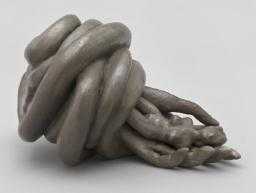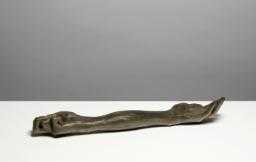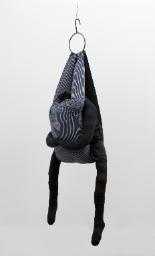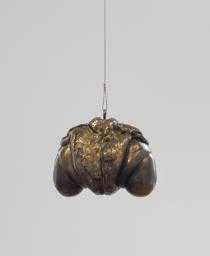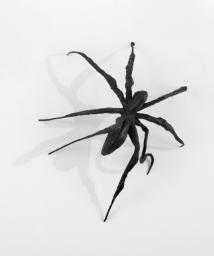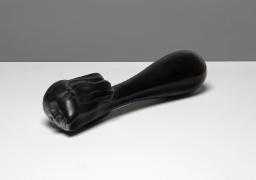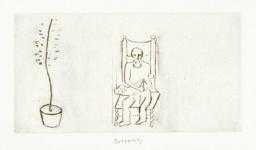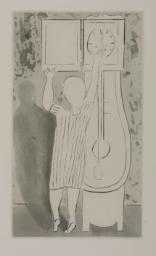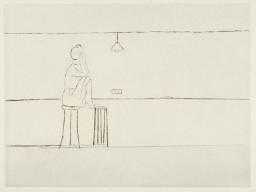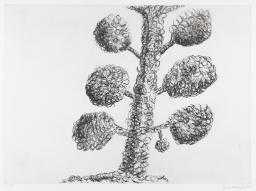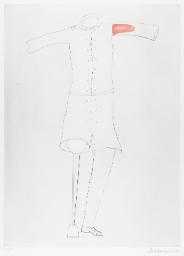
Not on display
- Artist
- Louise Bourgeois 1911–2010
- Medium
- Bronze, silver nitrate and brown patina, and granite
- Dimensions
- Object: 2743 × 4572 × 3785 mm, 256kg
- Collection
- ARTIST ROOMS
Tate and National Galleries of Scotland. Lent by The Easton Foundation 2013
On long term loan - Reference
- AL00354
Summary
Spider is a giant sculpture of an arachnid that stands on the floor. The artwork is made of bronze and granite and was created in 1994 by the French-born American artist Louise Bourgeois. One of the first of many sculptures of spiders made by the artist, Spider measures 2743 x 4572 x 3785 mm, such that it is large enough to occupy the entire space of a room. The body of the spider supports a rounded cage-like structure inside which is held a large white egg. The cage hangs below a cylindrical form, to which are attached eight thin legs stretching out to the floor. Each of the legs is articulated in three sections made of straight rods of bronze, with the exception of one of the legs, where the two sections are bent, creating a semi-circle. The lower parts of seven of the legs end in needle points where the sculpture meets the floor, while the eighth terminates in a small coil. The angularity of the thin legs and their different heights give the impression that the spider is crawling.
In 1995, the year after she made this version of Spider, Bourgeois published the poem ‘Ode to my Mother’ (‘Ode à ma mère’) alongside a suite of nine etchings depicting spiders that were published by Editions du Solstice, Paris. In the poem the artist relates the spider to a maternal figure, her own mother in particular, who was a weaver and the manager of the family’s antique tapestry restoration business:
The friend (the spider – why the spider?) because my best friend was my mother and she was deliberate, clever, patient, soothing, reasonable, dainty, subtle, indispensable, neat, and useful as an araignée. She could also defend herself, and me, by refusing to answer ‘stupid’, inquisitive, embarrassing personal questions.
I shall never tire of representing her.
I want to: eat, sleep, argue, hurt, destroy
Why do you?
My reasons belong exclusively to me.
The treatment of Fear.
(Quoted in Tate Modern 2000, p.62.)
The spider is a recurring motif in Bourgeois’s oeuvre. She first depicted it in a small ink and charcoal drawing of 1947 that was also entitled Spider, but the subject began to appear more frequently in her sculptures, drawings and prints in the mid-1990s, and she remained interested in the theme until late in life. The artist made sculptures of arachnids ranging in size from a small brooch to monumental outdoor works measuring over ten metres high. One of Bourgeois’s largest spider sculptures is the iconic Maman (Tate T12625), made of steel and marble in 1999 as part of her Turbine Hall commission for the opening of Tate Modern in London in May 2000. Other versions include Spider I 1995 (Tate AL00353).
Further reading
Louise Bourgeois, exhibition catalogue, Tate Modern, London 2000.
Louise Bourgeois: Maman, exhibition catalogue, Wanås Foundation and Atlantis, Stockholm 2007, reproduced p.79.
Ann Coxon, Louise Bourgeois, London 2010.
Natasha Adamou
May 2016
Does this text contain inaccurate information or language that you feel we should improve or change? We would like to hear from you.
Display caption
This large-scale bronze spider carries a granite egg in her sack, revealing Bourgeois’s interest in the creature as an image of the strong mother: protector, creator and repairer. In 1995 Bourgeois wrote a poem about her mother, who died when the artist was young. She compares her to a spider, ‘because my best friend was my mother and she was deliberate, clever, patient, soothing, reasonable, dainty, subtle, indispensable, neat, and useful as an araignée [spider]. She could also defend herself, and me…’
Gallery label, October 2016
Does this text contain inaccurate information or language that you feel we should improve or change? We would like to hear from you.
You might like
-
Louise Bourgeois Nature Study
1986 -
Louise Bourgeois Single II
1996 -
Louise Bourgeois Give or Take
2002 -
Louise Bourgeois Couple I
1996 -
Louise Bourgeois Janus Fleuri
1968 -
Louise Bourgeois Triptych for the Red Room
1994 -
Louise Bourgeois Spider I
1995 -
Louise Bourgeois Fallen Woman
1981 -
Louise Bourgeois Ode à Ma Mère
1995 -
Louise Bourgeois Paternity
1994 -
Louise Bourgeois Woman and Clock
1994 -
Louise Bourgeois Empty Nest
1994 -
Louise Bourgeois Children in Tub
1994 -
Louise Bourgeois Tree
1998 -
Louise Bourgeois Amputee with Peg Leg
1998

